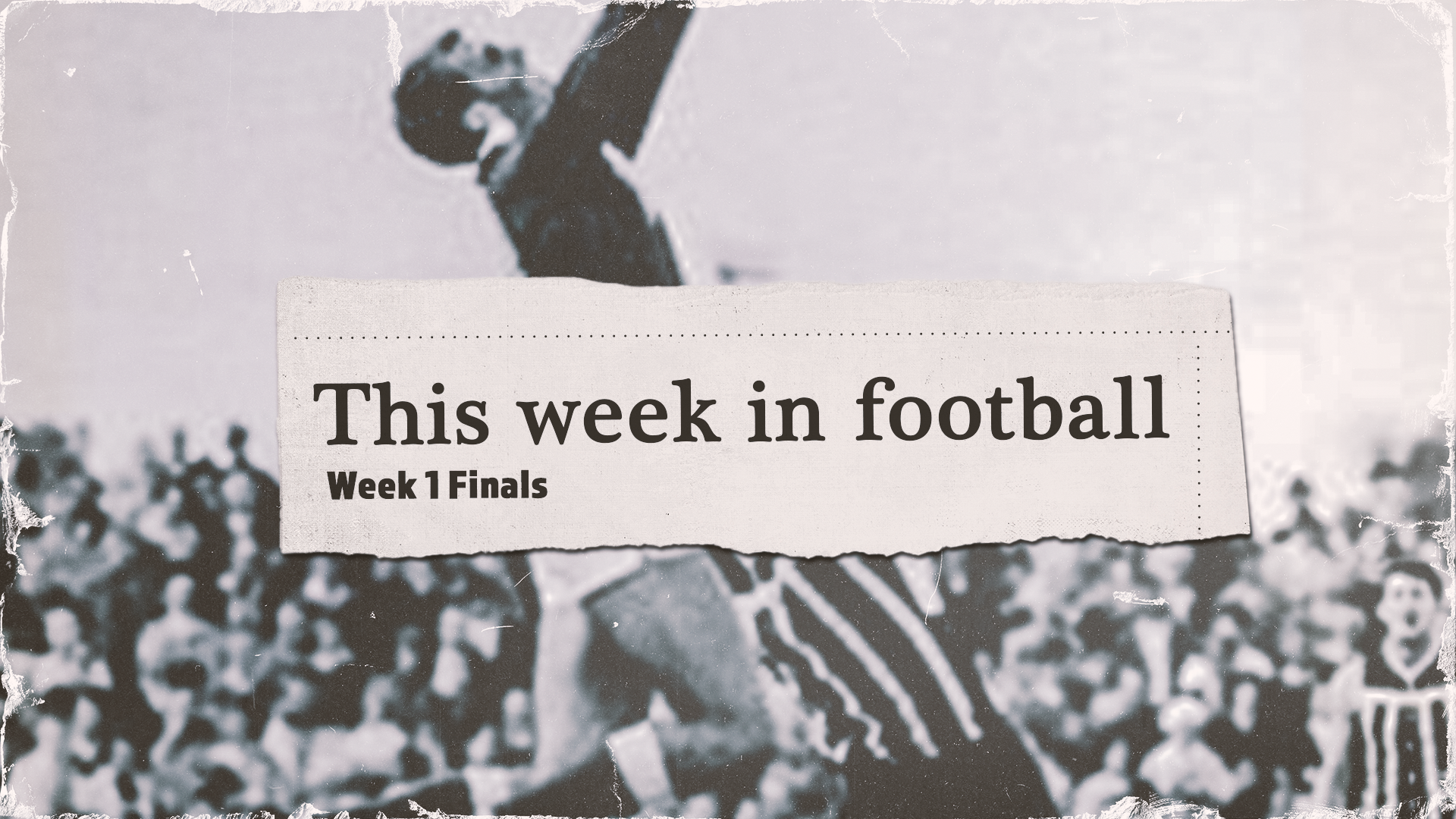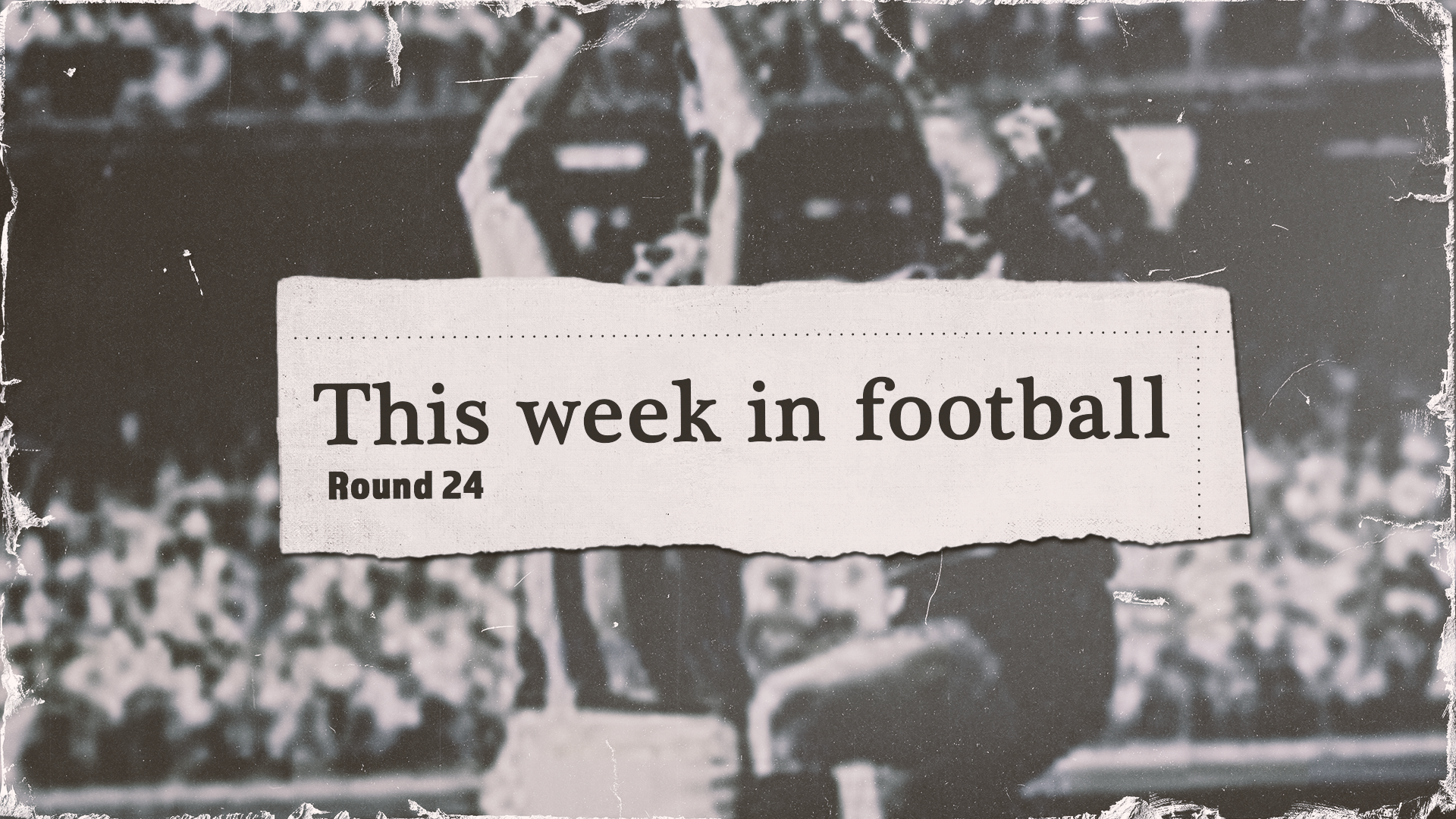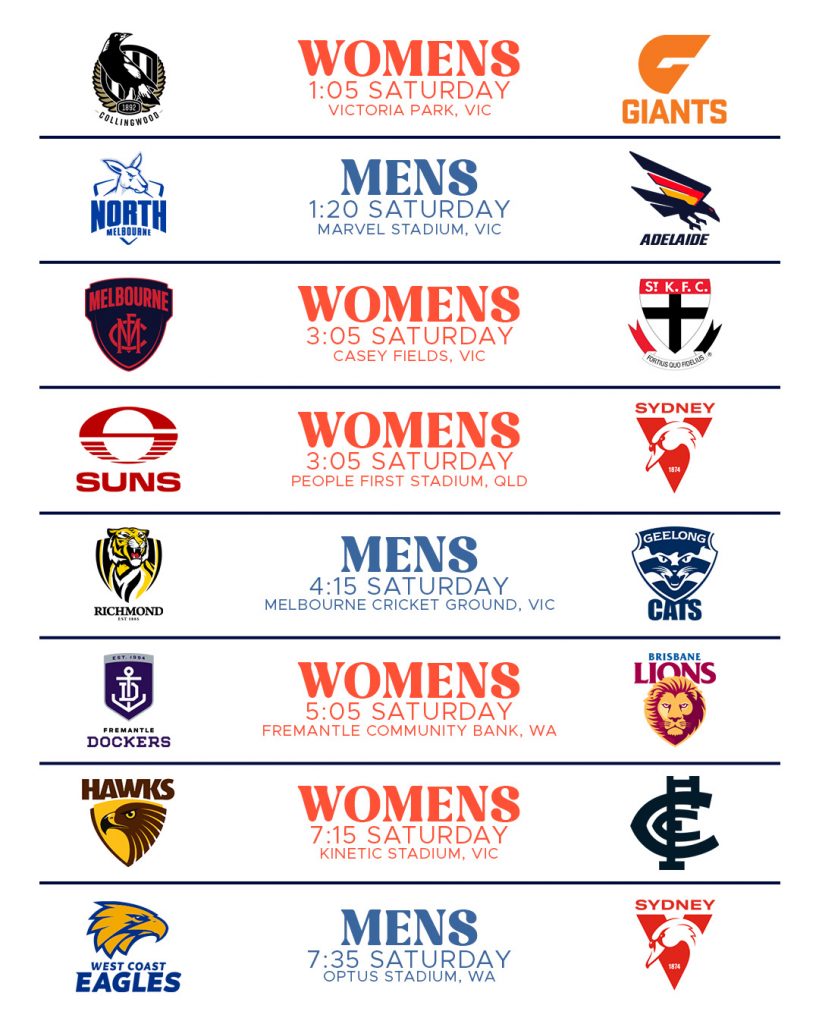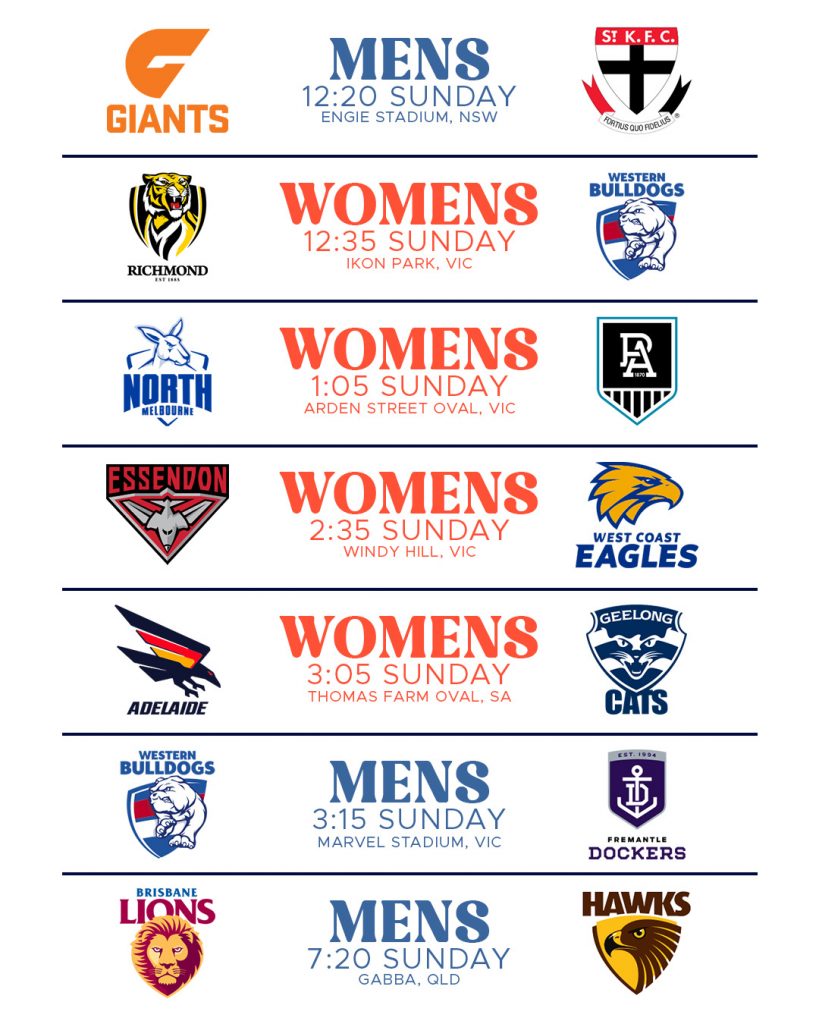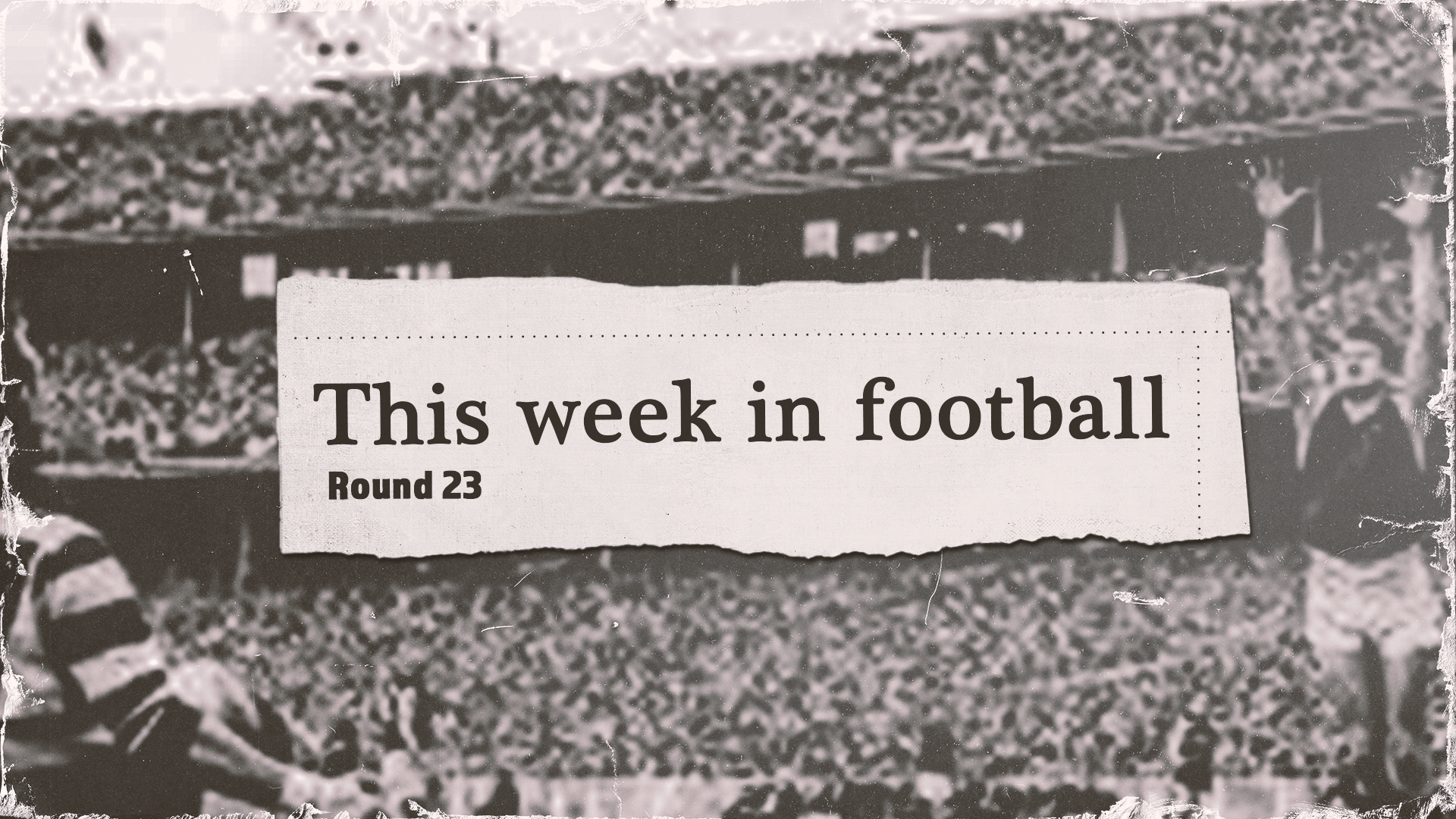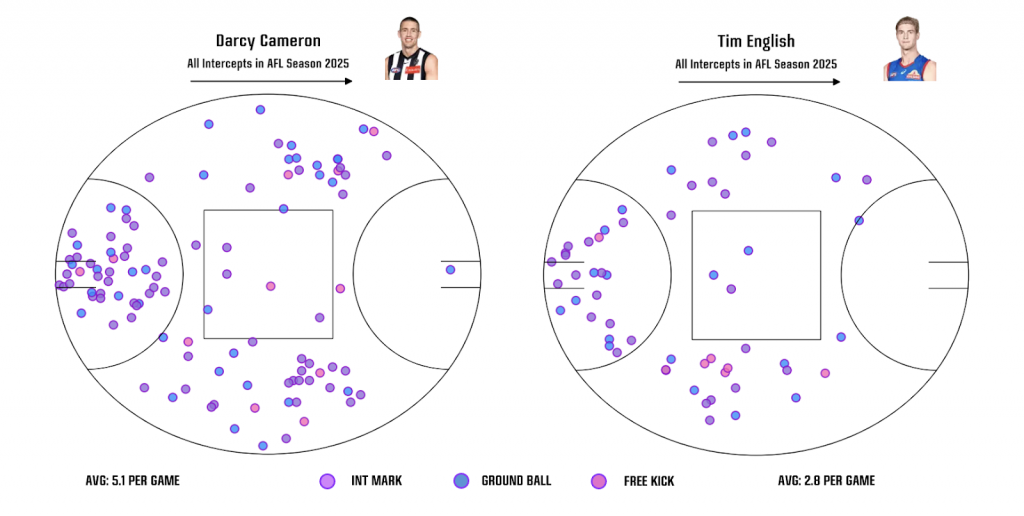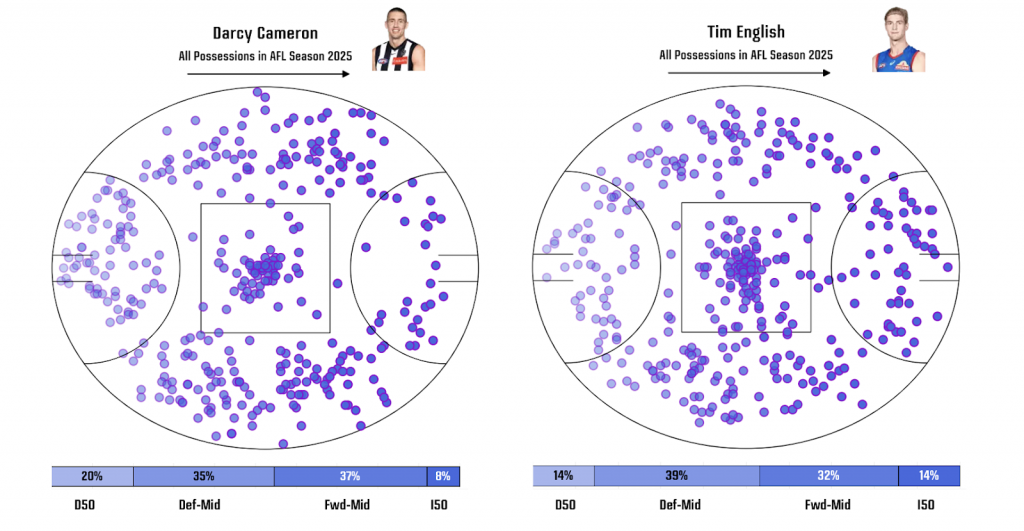This Week In Football is a collection of some of the best in football currently outside the walls of AFL clubs or broadcasters. Each week a curated grab bag from regular contributors and special guests will provide insight into and beyond the game on subjects of their choosing. For more about our contributors, click here.
Banner images by Polly Porridge of the True Bloods Podcast. Check out her other design work.
Before the Bounce
After what feels like near endless football, the men’s AFL finals are finally upon us. The game has successfully made it’s way to another finals series almost untouched.
With the exception of the introduction of a video boundary review system. In response to making 48 errors over 7,500 boundary decisions (or an error rate of 0.64%), the AFL has decided to unilaterally introduce the video review of boundary decisions in finals.
It’s unlikely to have a significant impact on how the finals will play out, and the review may not even be used in anger through the last month. However, there is something odd about introducing new rules for the finals without prior testing inside of the season to look for secondary impacts.
Or: why now?
This week (and for the rest of the finals) TWIF will look at each men’s final and preview what might turn each game. Our own James Ives has created “opposition analysis” style dashboards that provide a brief overview of how each side has played through the year and how they can be beaten.
This Week In Football we have:
Adelaide v Collingwood Preview
Words – Joe Cordy . Image – James Ives.
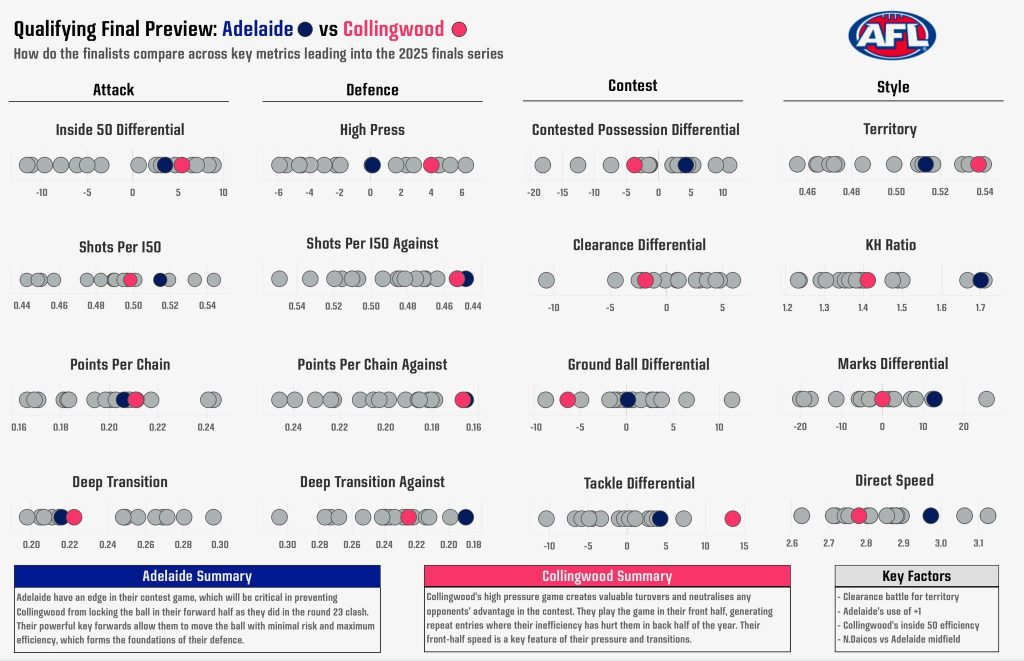
Since the beginning of the 16-team era in 1995, there have been 15 instances of teams playing each other in the last two weeks of the Home & Away Season and then immediately again in the first week of finals. Adelaide and Collingwood’s Qualifying Final will be the first of the 2020s however, and the first time either club finds itself in such a situation since 1995.
While a trip away to the minor premiers is a daunting task for anyone, Collingwood will be coming into it with the knowledge that they’ve already knocked off Adelaide once, and came excruciatingly close to completing the double in a game they won the Inside-50 count by 34. If they can recreate a similar volume of entries, it becomes a straightforward task of figuring out how to take advantage of them.
The most obvious answer is to incorporate the 211cm Mason Cox, who’s been brought into the side following the injury to Dan McStay, but it seems unlikely the 34 year old American is still up to the level. He’s only recorded 3 or more marks twice in the 2025 season, and only neither of his two in Collingwood’s round 10 victory against Adelaide came inside-50. A much more likely route to victory for Craig Macrae’s side is spreading the space at Adelaide Oval as much as possible to create uncontested marks inside 50, getting the ball into the hands of Elliott and Membrey who are both enjoying massively accurate seasons in front of goal.
For their opponents a much more difficult problem stands between them and a home preliminary final: how to execute their slingshot footy without Izak Rankine. A large part of what makes Adelaide so effective in games they lose the territory battle (currently sitting on a 6-3 record in 2025 when recording less inside-50s than their opponent) is their propensity to flood their D50, and then attack on the rebound with isolated tall forwards, elite kicks and sheer pace.
They’ll still have their pair of All Australians in Jordan Dawson and Riley Thilthorpe available in the early and finishing parts of these chains of possession, but Rankine created a connective tissue between midfield and forward areas that’s not easily replicated by others. In their first game following his suspension for using a homophobic slur, they were nearly caught out by perennial cellar dwellers North Melbourne. Even with two more weeks to recuperate and plan around Rankine’s absence, it may prove even more impactful against elite opposition.
Neither of the two sides are coming into the clash near full health or their best form. While the deciding factor could come from one or two moments of individual brilliance from the remaining stars on either side, it seems more likely it will be found in which of the two coaching groups better adapts their gameplan to compensate for the absence of key figures.
Geelong v Brisbane Preview
Words – Sean Lawson . Image – James Ives
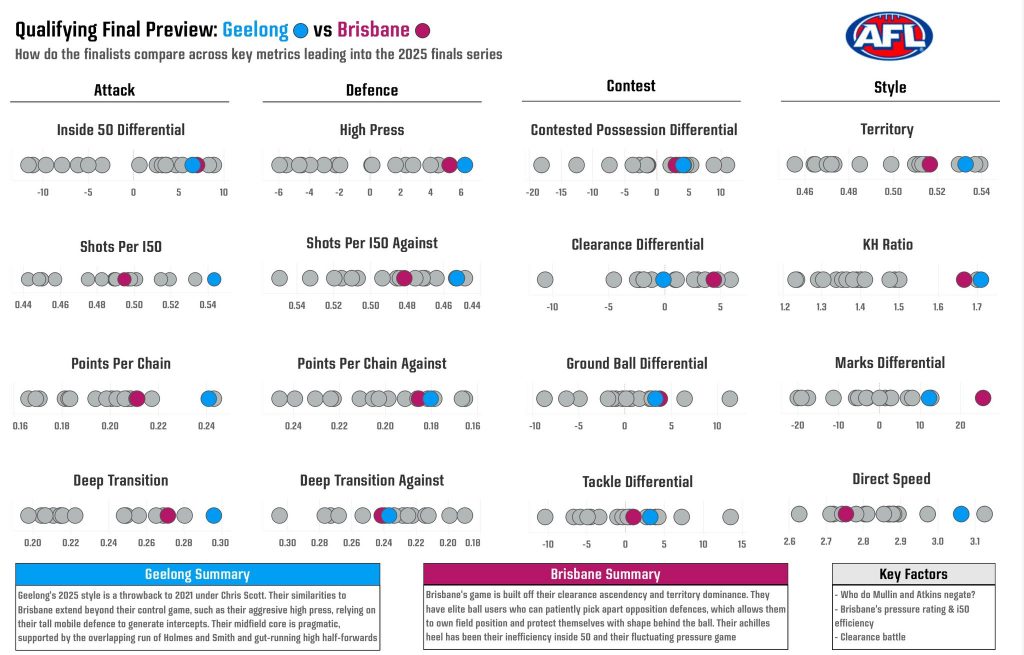
Brisbane have already beaten Geelong twice this year, including a comprehensive defeat at Kardinia Park in June. In both games, Brisbane have been able to get their possession and marking game going, moreso than the Cats. These two teams take the highest number of marks per game in 2025, with the Cats also the best marking side inside 50.
The difference at Kardinia was a combination of Geelong’s well below par goalkicking and Brisbane’s ability to transition on the Cats. A full third of the Lions defensive half chains went inside 50 – roughly average for the season as a whole for them, so holding up against strong opponents on their idiosyncratic home deck is a big positive.
A fun element to watch will be the midfield matchups byplay. Last time around, Lachie Neale was relatively well curbed and the Lions found success through others, especially as they looked to make Bailey Smith accountable with a Hugh McLuggage matchup, while the Cats tried to work their defensive midfielder Mark O’Connor onto him instead.The confusion this created led to a number of solid clearance opportunities for Brisbane, and surely Geelong will have something different up their sleeve this time around.
GWS v Hawthorn Preview
Words – Cody Atkinson . Image – James Ives
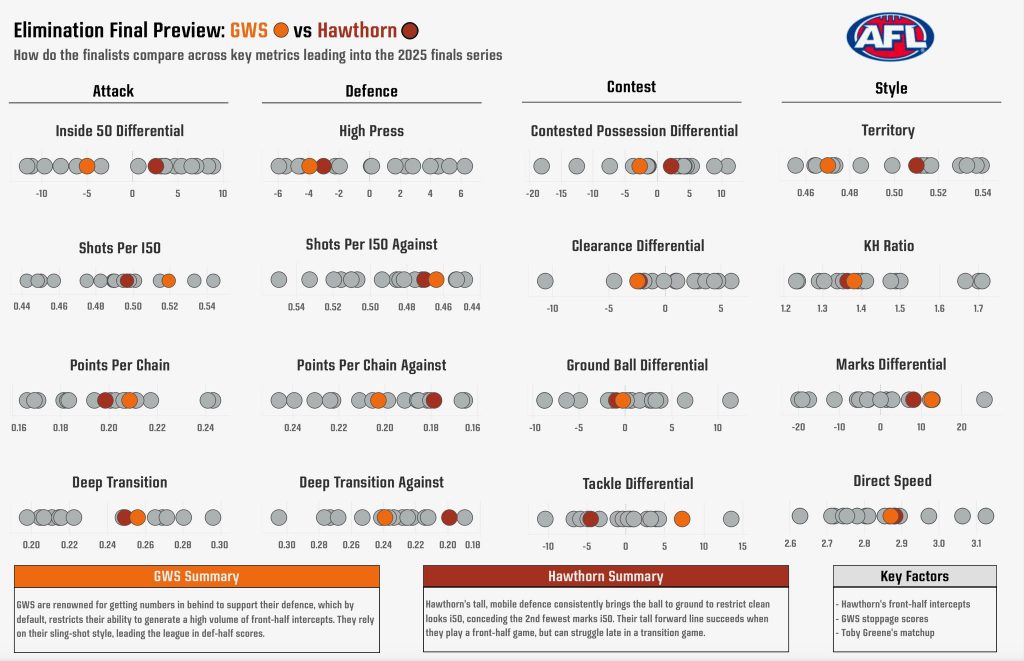
Hawthorn and GWS might not be footballing twins, but there’s parts of each side’s game that might cause you to do a double take every now and again.
There’s some elements that look similar. Both like to throw at least an extra behind the ball. Both sides look their best when they transition up the ground with some pace.
Neither side focuses on winning raw numbers of clearances, instead focusing on the stoppage rebound. When both sides win the ball from stoppage, they tend to put more points on the scoreboard than most sides.
Both sides tend to deploy a very tall set up in the forward line, boasting relatively mobile key position players that can cover pressure gaps.
But there are some differences at play.
Hawthorn places more pressure on the ball when they don’t have it, while GWS tends to protect valuable space and folds back a bit more readily. GWS tackles slightly more than Hawthorn, while the Hawks hold space and block escape routes for the opposition.
The Hawks also tend to prioritise raw territory a little more than the Giants, with the Sam Taylor led backline allowing the Giants to soak up repeated entries at will.
Both teams can occasionally look mercurial to the outside, or flaky to critics. They are both prone to putting runs of goals on the scoreboard, or allowing them going the other way. Part of this is down to both sides’ brands of footy.
The last two times these sides played saw these intense swings. In round 4 this year GWS got out to a 35 point lead in the first quarter before Hawthorn wiped out the advantage by halftime. The Hawks held on narrowly there, but it was a close encounter.
In round 22 last year Hawthorn took a 28 point lead into the last quarter before getting run down by an increasingly urgent Giants side.
There might be some fireworks in this match.
Fremantle v GC preview
Words – Jack Turner. Image – James Ives.
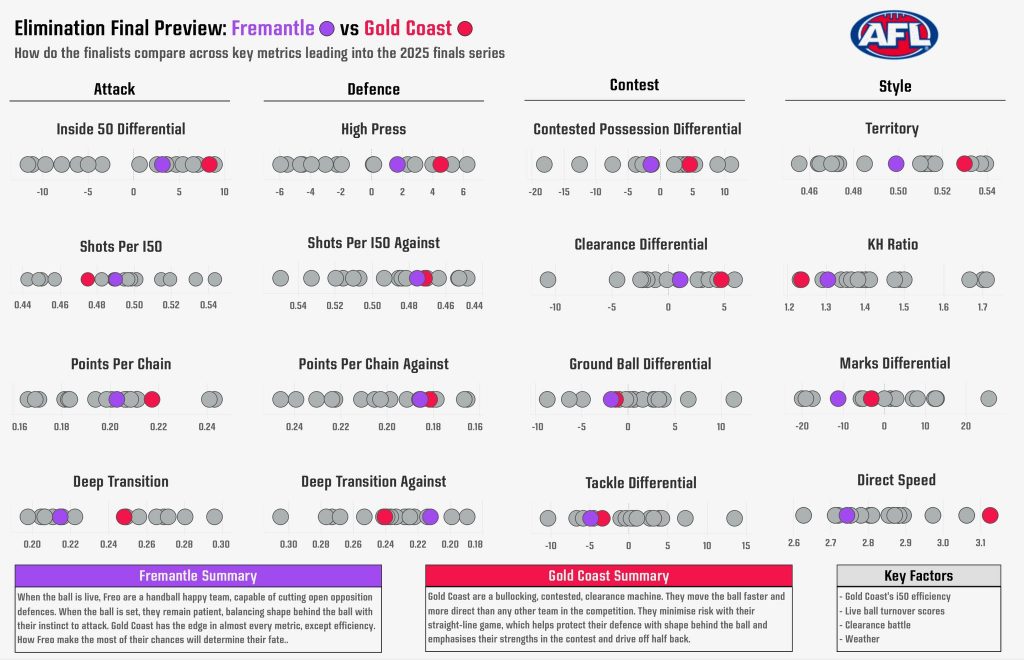
Fremantle and Gold Coast enter the finals as the two least experienced teams and the two regarded as least likely to win the flag. Each boast a talismanic veteran and former captain who is set to retire upon their next loss. Fremantle is looking for the fairytale finish for Nat Fyfe and the Suns for David Swallow. Both men needing to at least make a preliminary final to reach 250 games before retiring.
Fremantle have been somewhat of an enigma this year, with inspiring wins against Collingwood, the Suns, and Adelaide, countered by confusing and disheartening losses thumpings at the hands of Geelong, St Kildaand Brisbane, and an equally perplexing close away loss against Melbourne.
The Dockers’ best football is fast and highly skilled, utilising the outside run of Shai Bolton and Murphy Reid to create scores, the utility of Luke Jackson in their divisive two rucks setup, and their well drilled midfield group to make them the second strongest centre clearance team in the finals this year – behind only their opposition in the Suns.
Early in the season, the Suns looked as if they were destined to be a team that beat up on lowly opponents but couldn’t stand the heat when it came to the big boys – with the exception of a controversial win against Adelaide in Round 4 – but this proved not to be the case. They won games post bye – a time they have been historically poor – against Collingwood and Brisbane to sure up their spot in the finals, and despite a loss against an inspired Port Adelaide side in Hinkley and Boak’s farewell match Gold Coast dished out the biggest win in their club history to wrap the season, confirming their first ever finals berth.
The last time these two teams met, Fremantle proved too strong, winning out by just 11 points in a seesawing contest in the wet, where the Suns surged back to within a goal with just minutes to go. If you’re a believer in xScore – or even someone who likes using it as a tool – then it makes this matchup even more interesting to know that Gold Coast won on xScore by four points the last time they met, with a 15 point turnaround from the actual scoreboard.
Keep an eye out not only for the obvious matchups between these two midfields, as names like Serong, Anderson, Brayshaw and Rowell go head to head, but also on Alex Pearce lining up on Ben King, and Sam Collins trying to outmuscle the goliath that is Patrick Voss. That may well be where this game is won and lost. Harris Andrews recently took Voss out of the game and disrupted Fremantle’s forays forward, and we saw Sam Taylor force Ben King high up the ground, ruining Gold Coast’s structure inside 50.
Will either team go all the way? Can either retiring veteran prove to be the spark or motivation their teammates need to find that extra level? Only one team can keep the fairytale alive, and we will know which it is by 9pm AWST on Saturday night.
The AFLW’s Scoring Boom
Joe Cordy
When the final siren went on Gold Coast vs Sydney, the Swans’ 103 points was the third highest score in the competition’s history, and only the fourth to reach triple digits.
Eight days and fourteen games later, it’s not even on the podium for the 2025 season.
It was knocked out of the bronze spot for all-time scores on the same day by Brisbane’s 35-105 victory over Walyalup, before Yartapulti’s 108-40 game against Gold Coast and the Kangaroos’ 14-114 demolition of Walyalup each set a new gold standard less than 24 hours apart.
The Kangaroos’ win was so comprehensive they set three other scoring records: the longest single game goal-streak in AFLW history (15), the highest margin in league history, and the first game to ever record a 100-point margin.
These four games are part of a wider trend of increased scoring across the AFLW. The league has gone through several massively impactful transformations in its first nine seasons, both planned and unplanned, but despite some volatile year to year variance scoring per game has generally trended upwards.
While the lack of location data prior to the 2025 season precludes anyone making an xScore model for the AFLW, a rough approximation of it from points per shot shows that accuracy has remained reasonably stable across the league’s lifetime, typically hovering just under three points per shot.
The bigger indicator in the rise of scoring has come from volume, rather than quality or execution, of looks at the goal.
The 2025 average of 14.5 per game is over a whole shot higher than the previous high watermark set in 2023, and thus far six of the eight highest volume shooting teams in league history have all come about this season.
While this is obviously going to regress back towards the mean as the sample size grows and the good teams play more against each other than bottom of the ladder opposition, it does match the eye test of the dangerous teams looking more co-ordinated than ever.
Gemma Bastiani on Deep Dive broke down how Sydney work as one to create space, thinking two and three disposals ahead in the chain to support each other and pull apart opposition defences. It’s a level of tactical sophistication and cohesion that’s only been able to be achieved with significantly longer pre-seasons and contact hours with the club, which itself is downwind of salaries making footy viable as a full-time career.
In 2023 the AFLPA signed the first ever joint Collective Bargaining Agreement (CBA) between the players of the men’s and women’s competitions. The joint bargaining power led to a breadth of changes for the AFLW, but the most important was the staggering increase in guaranteed payments for each player.
The AFLW doesn’t have a salary cap, instead opting for a tiered structure where clubs can offer two Tier 1 contracts, six Tier 2 and Tier 3 contracts, and sixteen Tier 4 contracts. Until 2022, the Tier 4 contracts that made up the bulk of any club’s list were below the tax-free threshold in Australia. Immediately following the joint CBA, Tier 4 contracts became worth more than Tier 1 contracts the year before by over $14,000.
While this was still only marginally above minimum wage for full-time work in 2023, 2025 has seen a significant jump within the five-year lifespan of the CBA. Tier 4 contracts are now competitive with starting salaries in most industries, and Tier 1 contracts for each club’s best and brightest have now reached six figures for the first time.
Unsurprisingly, giving all players enough financial security to focus on footy as a full-time profession has given them a strong base to build off for the season, and their newfound fitness and preparation time as groups has created the best footy the competition’s ever seen.
The Race to 100 AFLW Goals
Emlyn Breese / CreditToDuBois.com
We’re in the tenth season of the AFLW and there’s a solid chance this is the season we see someone break the 100 career goals barrier.
The increase in scoring, as Joe talks about above, has lead to individual players kicking more goals.
There are four players who, if they maintain their current 2025 goals average for the rest of the season would hit 100 goals before finals.
We should place an asterisk on Jasmine Garner though, as she’s set to miss two to three weeks through injury so would need to pick up a couple of goals when she returns.
How did we get here?
There have been a total of 8 players who have held the careers goals record at some point, either jointly or by themselves. From Lauren Arnell sharing it for three minutes in game 1 of season 1, to Darcy Vescio holding it a combined three and a half years.
It is a seriously accomplished list. Darcy Vescio, Erin Phillips, Tayla Harris, and Jasmine Garner are among the most recognizable players in the competition’s history.
Kate Hore is a club captain, premiership player, and three-time All Australian. Danielle Ponter was a key part of Adelaide’s 2019 and 2022 premierships, while Jess Wuetschner is one of the most dangerous small forwards the league has seen.
Lauren Arnell isn’t notable as a goalkicker but is a premiership player, three-time all Australian, and the first AFLW player to go from playing in the league to coaching in it.
Here’s the progression of those eight players goalkicking tallies – goal by goal, minute by minute.
There’s also some worth in seeing who had the goalkicking title and for how long.
If there was a favourite right now for who’s going to get to 100 goals first, Kate Hore seems like an easy choice. Whoever it is it will be a moment for the whole competition to celebrate.
